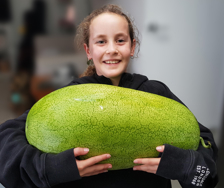Coloured Capsicum are popular nowadays, with red, orange and yellow dominating the shelves along with their unripe cousins. Green is always the cheapest as the more the farmer picks, the more pepoers he gets, letting them ripen to colour up reduces the plants output, hence the higher price.
What we don't see is Purple.
Pure is not an unusual colour in the nightshade family, Aubergine is both a colour and a vegetable, also known as Brinjal and Eggplant. The dark tomatoes are also Purple. Black is not a natural colour in botanical terms.
In the capsicum branch, purple is prolific and growers tend to always have an option or 2. The main reason for them not being so popular is they are usually on the hotter side of popular. Tequila is a variety of sweet bell pepper that is available as seedlings and less easily as seed. Cayenne has a purple option too
Pictured are firstly Purple UFO. This one ripens red and packs a punch with flavour and heat. This was grown as a competition plant in a can. I grew it over winter against the northern hemisphere summer plants. It did not place, but was a fun project.
Next is the black scorpion Tonge. A hot salty apple flavour make this a great pepper to make a salsa to go with pulled pork tacos. This unique pepper is the rarest in my collection. It ripens from purple turning yellow when starting to ripen through orange to red. They are best used mixed 50/50 purples and reds.
Chiero Roxa is next. This one ripens to pinks and peachy colours. Also a hot Chinense, it's adavtage is it is sweeter and does not have the earthy under notes of th habanero. It is also tamer in the heat levels at about 1/3 of the heat.
No collection is complete without a cayenne. Long and traditional shaped, though not a true purple. The chilli is green and the light exposure makes it purple. This happens with some other lighter pepoers, and Jalapeño varieties. This makes an attractive cayenne variant. Flavour wise I find no different to a standard cayenne.
Lastly I had to include a purple flower, which all again is quite common in the capsicum varieties of annum and Chinense, just because they are so very pretty.










Share
Share this blog on social media